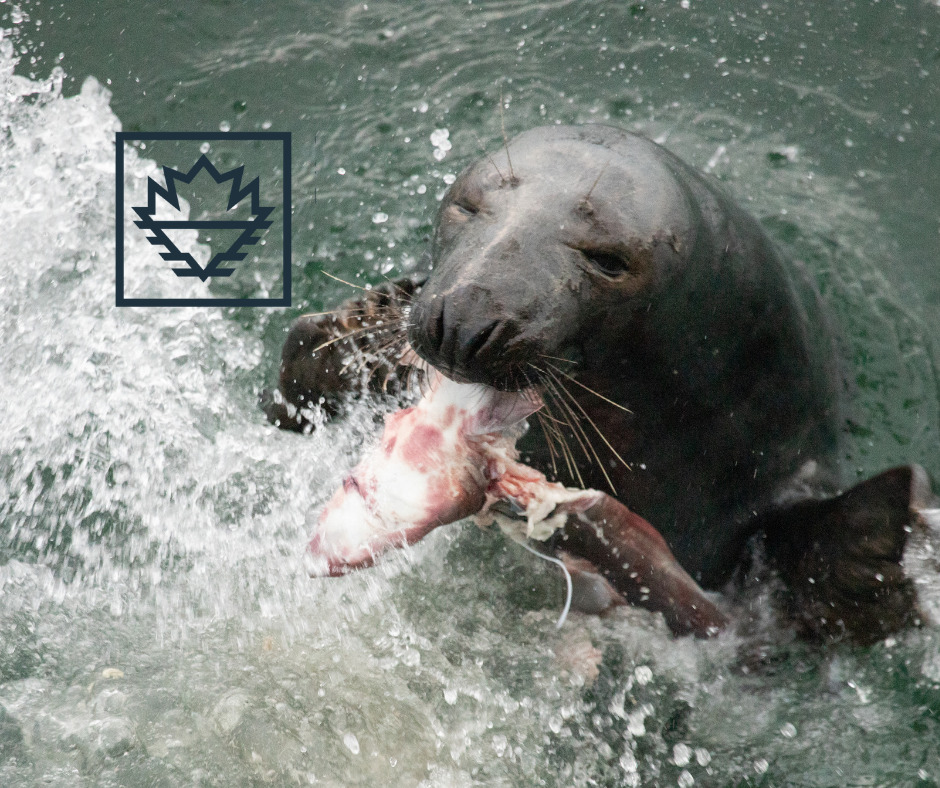Myths and realities on the seal harvest
The Canadian seal populations are healthy and growing and seal harvest is practiced according to strict management regulations as well as a science-based quota determined by the Government of Canada. Harvesters are licensed and trained to follow best practices. Despite these facts, there are still some rumors and misunderstandings about the Canadian Sealing industry. Below are 8 myths and realities about the Canadian seal hunt.
Myth #1: The Canadian government allows sealers to kill whitecoat seals.
First of all, whitecoat is not a special specie of seals. It refers to a newborn harp seal pup with white fur. Harp seal pups are born with long white fur that helps them absorb sunlight and stay warm since they haven’t developed thick blubber [1]. The harp seal is the best-known and the most abundant seal species. Worldwide, the total population of harp seals is estimated at nearly 7.6 million today[2].

Activists are out in strength to condemn Canadians as baby seal killers. However, since 1987, hunting harp seal pups (whitecoats), as well as hooded seal pups (bluebacks), has been legally banned in Canada. Traditionally, Inuit hunters also never target whitecoats. All the seals that are harvested are self-reliant, independent animals. The seals that are hunted have been weaned by their mother and are totally on their own. They can’t be considered as pups.
Myth #2: Seals are being skinned alive.
In 1964, a filmmaker had paid a hunter to skin a seal pup alive [3], and the act of cruelty was described as a typical seal hunt practice. The documentary was broadcasted on May 17, 1964, on Radio Canada. The seal hunter was skinning a live baby seal which continued to wriggle as the knife cut it right through. However, a few years later, this same hunt reportedly admitted that he had been paid by the film crew to skin a live whitecoat. Even though the documentary was a complete fraud, this only “evidence” has been used repeatedly by animal activists for decades. The public also did not seem interested in knowing the truth. People believed that seals were skinned alive, dying slowly and painfully. Independent international veterinarians and European Food Safety Authority (EFSA) experts also concluded that the claims from anti-sealing groups, regarding the fact that seals were skinned alive, were false.
Myth #3: Seal clubbing – or hakapik – is a barbaric and inhumane tool that has no place in today’s world.
Seal hunting methods were studied by the Royal Commission on Seals and Sealing in Canada and it was found that the clubbing of seals, when properly performed, is at least as humane as, and often more humane than, the killing methods used in commercial slaughterhouses (the methods used for cows or chickens), which are accepted by the majority of the public.
A hakapik is a heavy wooden club and has a hook on the end. It was designed by Norwegians for hunting seals. A hakapik is an efficient tool designed to kill an animal quickly and humanely. Compared to a hakapik, a rifle might be less effective because it needs to target the seal head. Both of the methods are considered by experts to be humane. However, multiple studies, such as the one published in the Canadian Veterinary Journal in 2002 have explained why the hakapik (or club) is the best tool to hunt harp seals or grey seals. [4] Seal hunting is no less humane than any other animal hunt.
Myth #4: The Canadian Government is allowing sealers to kill thousands of seals to help with the recovery of cod stocks.
The Canadian government is not allowing sealers to kill seals without limit. In 2020, the total allowable catch for Harp seals was 400,000 and 60,000 for Grey seals. The total allowable catch limit for harp seals represents only 5% of its population. DFO sets annual quotas at levels that guarantee the wellbeing and abundance of seal populations and takes several factors into consideration, such as ice conditions, incidental bycatch, the Greenland and Arctic hunt, and potential quota over-runs when making decisions. The commercial quota is determined on seal population preservation principles, not on the purpose of assisting the recovery of cod stocks. Even though substantial mortality of juvenile cod due to predation particularly by grey seals was observed, the government is basing its decision on grey seal population reduction on scientific analysis [5].
Myth #5: The hunt is unsustainable and is endangering the harp seal population.
None of the seal species hunted in Canada is endangered, especially the harp seals. IUCN (International Union for Conservation of Nature) is the global authority on analyzing the global conservation status of plant and animal species. The Harp seal is one of the ‘Least Concern’ species listed by the IUCN.
Canada’s total seal population is estimated at more than 10 million [6]. It is the largest number ever observed by the Department of Fisheries and Oceans. The Northwest Atlantic harp seal population is healthy and abundant with an estimated population that’s grown nearly 60% to 7.6 million since 1994 [6]. DFO determined annual hunt quotas at levels that guarantee the health and abundance of the seal population.
The harp seal population will keep growing. The figure below illustrates the Northwest Atlantic harp seal population under different model assumptions and under an annual harvest of 325,000 animals. The dotted lines are the 95% confidence intervals for the exponential growth model [7].

Myth #6: The seal hunt provides such low economic return for sealers that it is not an economically viable industry.
In many Canadian Northeast communities, seal hunting was the key factor that allowed the resident to settle down year-round in the area. As a local and sustainable food source, the economic benefits of seal hunt are difficult to evaluate in a dollar value. Especially in areas like the high north, where food security is always an issue until now, seal meat is a vital food for the communities. Seal hunting still contributes to the annual income of people living in remote coastal communities where other economic opportunities are limited, which may reduce outmigration to large urban centers. The seal harvest provides direct employment for thousands of people per year on annual basis. In some communities, over 25% of households take part in seal hunting, and among those people, hunting can account for 25-35% of their annual income. It is not a small group of people that benefits from the hunt. In addition to economic benefits seal harvest also provide health, nutritional and cultural benefits.

Just before the EU ban on seal products, in 2006, the landed value of harp seals was around $30 million. A recent study estimated that today, the replacement food value of seal meat is worth approximately $5 million. Seal skin products are worth an additional $1 million to the arts and crafts sector of the Nunavut economy [8].
Myth #7: Fisheries and Oceans Canada (DFO) provides subsidies for the seal hunt.
DFO does not subsidize the seal hunt. Any funding provided were for market and product Research & Development to support full utilization of the seal. The Certification and Market Access Program for Seals (CMAPS) was a $5.7 million, five-year program that ran until the end of the end of 2020. CMAPS funded the development of certification and tracking systems so that seal products harvested by Indigenous communities can be certified to be sold in the European Union (EU) [8]. The project that were funded were in majority related to market development of seal products. In fact, the Canadian Government has provided much less funding to the sealing industry than what was recommended by the Royal Commission on Seals and Sealing.
Myth #8: The seal hunt is loosely monitored and DFO doesn’t punish illegal hunting activity or practices.
Canadian seal hunting is the most heavily monitored animal hunt in the world. Fisheries officers monitor the seal hunting activities 24/7 during the hunting season. The RCMP, Quebec provincial police, and at-sea observers are also working to monitor the hunt and enforce the Canadian Marine Mammal Regulations.
Fishery officers conduct surveillance of sealers and sealing activities using aerial surveillance; vessel monitoring systems (satellite tracking); at-sea patrols and inspections; dockside/landing site patrols and inspections; and inspections at buyer/processor sites/facilities. The Canadian Coast Guard provides ship and helicopter support and monitoring, and enforcement is augmented as needed by the RCMP and the Quebec provincial police.
A 96% of compliance rate with the MMR has been observed based on approximately 3,000 fishery officer inspections over the last 5 years [9]. Infractions are taken very seriously and sealers who violate Canada’s Marine Mammal Regulations are penalized. The consequences of illegal actions could include court-imposed fines, license prohibitions, and the forfeiting of catches, fishing gear, vessels, and vehicles.
References
[1] https://oceana.org/marine-life/harp-seal/
[2] https://waves-vagues.dfo-mpo.gc.ca/Library/40958899.pdf
[4] https://www.ncbi.nlm.nih.gov/pmc/articles/PMC339547/
[5] https://www.dfo-mpo.gc.ca/fisheries-peches/initiatives/cod-morue/strategic-mar-eng.html
[6] https://waves-vagues.dfo-mpo.gc.ca/Library/40958899.pdf
[7] http://canadiansealproducts.ficwebhosting.com/the-canadian-seal/sustainability-ecosystem
[8] https://www.gov.nu.ca/sites/default/files/final_gn_info_package_-_economy.pdf
[9] http://canadiansealproducts.ficwebhosting.com/the-canadian-seal/humane-professional





